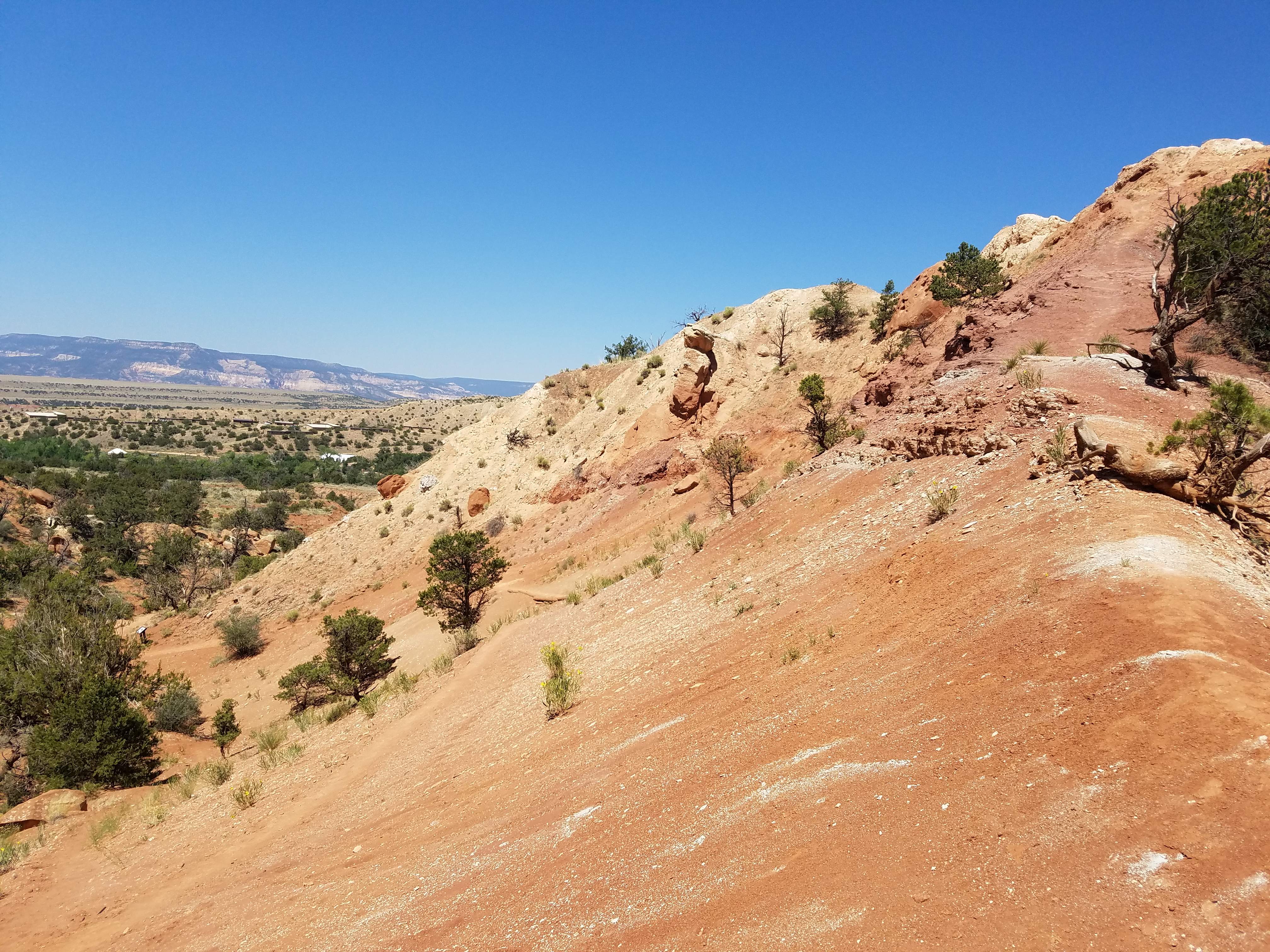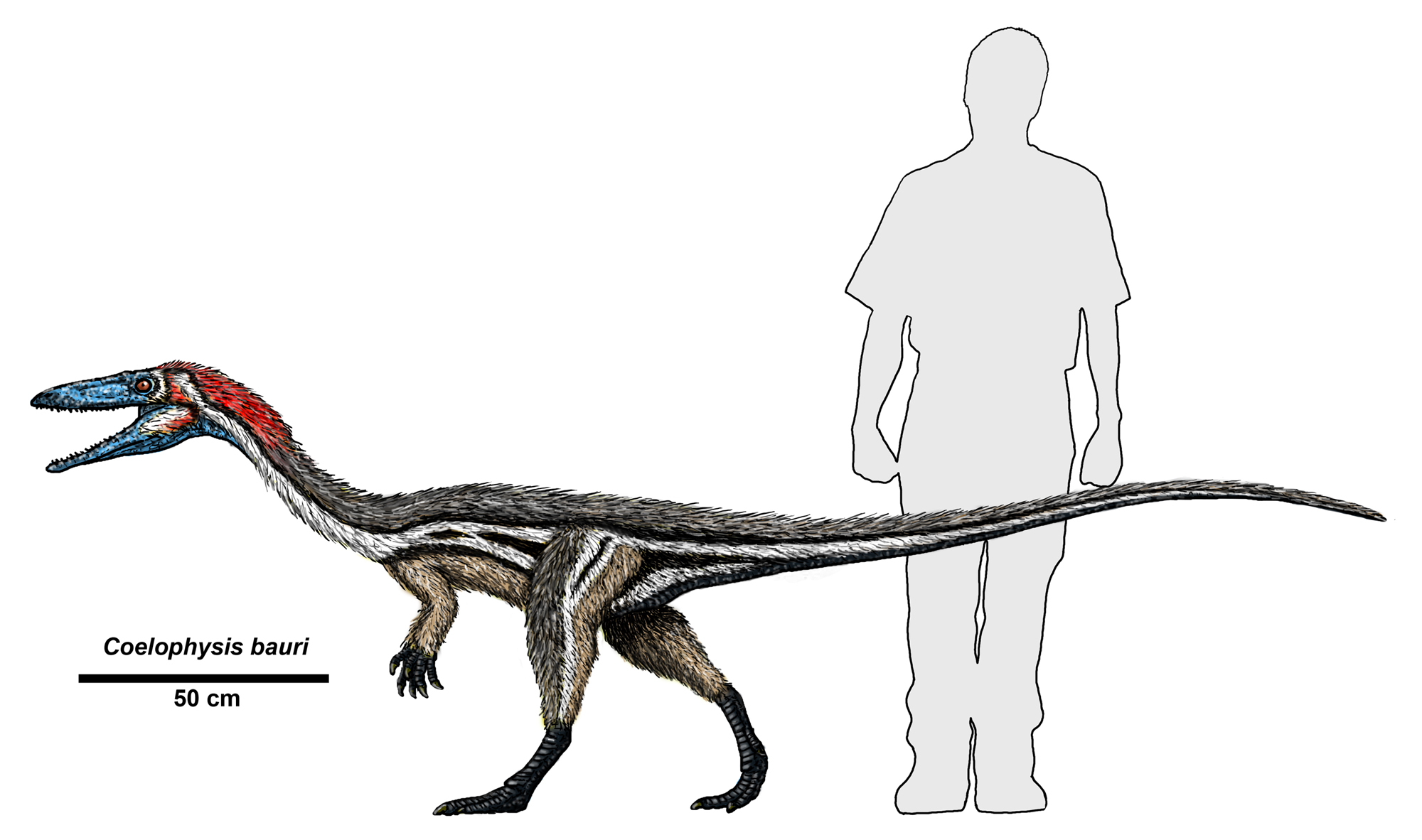|
Coelophysoids
Coelophysoidea were common dinosaurs of the Late Triassic and Early Jurassic periods. They were widespread geographically, probably living on all continents. Coelophysoids were all slender, carnivorous forms with a superficial similarity to the coelurosaurs, with which they were formerly classified, and some species had delicate cranial crests. Sizes range from about 1 to 6 m in length. It is unknown what kind of external covering coelophysoids had, and various artists have portrayed them as either scaly or feathered. Some species may have lived in packs, as inferred from sites where numerous individuals have been found together. Examples of coelophysoids include ''Coelophysis'', ''Procompsognathus'' and ''Liliensternus''. Most dinosaurs formerly referred to as being in the dubious taxon "Podokesauridae" are now classified as coelophysoids. Classification Despite their very early occurrence in the fossil record, coelophysoids have a number of derived features that separate the ... [...More Info...] [...Related Items...] OR: [Wikipedia] [Google] [Baidu] |
|
 |
Coelophysis
''Coelophysis'' ( traditionally; or , as heard more commonly in recent decades) is an extinct genus of coelophysid theropod dinosaur that lived approximately 228 to 201.3 million years ago during the latter part of the Triassic Period from the Carnian and Rhaetian faunal stages in what is now the southwestern United States. ''Megapnosaurus'' was once considered a species within this genus,Weishampel, David B; et al. (2004). "Dinosaur distribution (Early Jurassic, Africa)." In: Weishampel, David B.; Dodson, Peter; and Osmólska, Halszka (eds.): The Dinosauria, 2nd, Berkeley: University of California Press. Pp. 535–536. but this interpretation has been challenged since 2017 and the genus ''Megapnosaurus'' is now considered valid. ''Coelophysis'' was a small, slenderly-built, ground-dwelling, bipedal carnivore that could grow up to long. It is one of the earliest known dinosaur genera. Scattered material representing similar animals has been found worldwide in some Late Tria ... [...More Info...] [...Related Items...] OR: [Wikipedia] [Google] [Baidu] |
|
Gojirasaurus
''Gojirasaurs'' (meaning "Godzilla lizard")K. Carpenter, 1997, "A giant coelophysoid (Ceratosauria) theropod from the Upper Triassic of New Mexico, USA", ''Neues Jahrbuch für Geologie und Paläontologie, Abhandlungen'' 205 (#2): 189-208 is genus of coelophysoid theropod dinosaur named after the giant monster movie character Gojira (the Hepburn romanized Japanese name for the monster Godzilla). Etymology The composite term ''Gojirasaurus'' is derived from the name of the giant Japanese movie monster "Gojira" (Godzilla) and the Greek word "" () meaning "lizard"; thus, "Godzilla lizard". In addition, a theropod dinosaur with the name ''Godzillasaurus'' exists in the Heisei era of ''Godzilla'' films, and in that continuity is explained to be the non mutated form of Godzilla. "Gojira" was selected as a reference to the great size of this theropod, which exceeded that of its Triassic counterparts. The specific name ''quayi'', is a reference to Quay County, New Mexico, where the ... [...More Info...] [...Related Items...] OR: [Wikipedia] [Google] [Baidu] |
|
 |
Procompsognathus
''Procompsognathus'' is an extinct genus of coelophysid theropod dinosaur that lived approximately 210 million years ago during the later part of the Triassic Period, in what is now Germany. ''Procompsognathus'' was a small-sized, lightly built, ground-dwelling, bipedal carnivore, that could grow up to 1 m (3.3 ft) long. Discovery and naming The fragmentary and poorly preserved skeleton of ''Procompsognathus'' was found in the Middle Stubensandstein member of the Löwenstein Formation at the ''Weiße Steinbruch'', the quarry of Albert Burrer on the northern slopes of the Stromberg region near Pfaffenheim in Württemberg, Germany. The discovery was made by Albert Burrer in the spring of 1909 in white sandstone and gray/blue marl sediments that were deposited during the Norian stage of the Triassic period, approximately 210 million years ago. The holotype SMNS 12591, consisted of three blocks of sandstone: one showed a small, seven-centimetre-long, severely crushed sk ... [...More Info...] [...Related Items...] OR: [Wikipedia] [Google] [Baidu] |
|
Coelophysidae
Coelophysidae is a family of primitive carnivorous theropod dinosaurs. Most species were relatively small in size. The family flourished in the Late Triassic and Early Jurassic periods, and has been found on numerous continents. Many members of Coelophysidae are characterized by long, slender skulls and light skeletons built for speed. One member genus, ''Coelophysis'', displays the earliest known furcula in a dinosaur. Under Cladistics, cladistic analysis, Coelophysidae was first defined by Paul Sereno in 1998 as the most recent common ancestor of ''Coelophysis, Coelophysis bauri'' and ''Procompsognathus, Procompsognathus triassicus'', and all of that common ancestor's descendants. However, Tykoski (2005) has advocated for the definition to change to include the additional taxa of Coelophysis kayentakatae, "Syntarsus" ''kayentakatae'' and ''Segisaurus halli''. Coelophysidae is part of the superfamily Coelophysoidea, which in turn is a subset of the larger Neotheropoda clade. As p ... [...More Info...] [...Related Items...] OR: [Wikipedia] [Google] [Baidu] |
|
|
Powellvenator
''Powellvenator'' (meaning "Jaime Powell's hunter") is an extinct genus of coelophysoid theropod dinosaur that lived during the latter part of the Triassic Period in what is now northwestern Argentina. Fossils of the dinosaur were found in the Los Colorados Formation of the Ischigualasto-Villa Unión Basin. The type species, ''Powellvenator podocitus'', was named by Martin Ezcurra in 2017. See also * 2017 in archosaur paleontology The year 2017 in archosaur paleontology was eventful. Archosaurs include the only living dinosaur group — birds — and the reptile crocodilians, plus all extinct dinosaurs, extinct crocodilian relatives, and pterosaurs. Archosaur palaeontology ... References Coelophysoids Norian life Late Triassic dinosaurs of South America Triassic Argentina Fossils of Argentina Los Colorados Formation Fossil taxa described in 2017 {{theropod-stub ... [...More Info...] [...Related Items...] OR: [Wikipedia] [Google] [Baidu] |
|
 |
Pendraig
''Pendraig'' (meaning "chief dragon" in Middle Welsh) is a genus of coelophysoid theropod dinosaur from South Wales. It contains one species, ''Pendraig milnerae'', named after Angela Milner. The specimen was discovered in the Pant-y-Ffynnon quarry. In life it would have measured in length. History The holotype of ''Pendraig'' were found in the Pant-y-ffynnon Quarry in Wales in 1952 by Kermack and Robinson along with the holotypes of ''Pantydraco'' and ''Terrestrisuchus'', and were subsequently lost in the collections of the Natural History Museum, London. The fossils were originally thought to belong to a "coelurosaur" (in the outdated sense of the word) and even subsequently classified as a species of "''Syntarsus''" (now ''Megapnosaurus'' or ''Coelophysis''). Recently Angela Milner and Susannah Maidment rediscovered the fossils stored with some crocodile bones (likely ''Terrestrisuchus''). The fossils were named as representing a new genus of theropod in 2021. Description ... [...More Info...] [...Related Items...] OR: [Wikipedia] [Google] [Baidu] |
 |
Liliensternus
''Liliensternus'' is an extinct genus of basal neotheropod dinosaur that lived approximately 210 million years ago during the latter part of the Triassic Period in what is now Germany. ''Liliensternus'' was a moderate-sized, bipedal, ground-dwelling carnivore, that could grow up to long. It is the best represented Triassic theropod from Europe and one of the largest known.Rauhut, O.M.W. & A. Hungerbuhler, 1998, "A review of European Triassic theropods". ''Gaia'' 15. 75-88. Description ''Liliensternus'' was approximately long, and may have weighed about . Other estimates suggest that ''Liliensternus'' was at best long and weighed at most. The remains of two specimens of ''Liliensternus'' together form a syntype series with inventory number MB.R.2175, and consist of the partial and fragmentary skeletons of at least two individuals, containing elements of the skull, the lower jaws, the vertebrae and the appendicular skeleton. The tibia (409 mm) is shorter than the femur (4 ... [...More Info...] [...Related Items...] OR: [Wikipedia] [Google] [Baidu] |
 |
Coelurus Bauri
''Coelophysis'' ( traditionally; or , as heard more commonly in recent decades) is an extinct genus of coelophysid theropod dinosaur that lived approximately 228 to 201.3 million years ago during the latter part of the Triassic Period from the Carnian and Rhaetian faunal stages in what is now the southwestern United States. ''Megapnosaurus'' was once considered a species within this genus,Weishampel, David B; et al. (2004). "Dinosaur distribution (Early Jurassic, Africa)." In: Weishampel, David B.; Dodson, Peter; and Osmólska, Halszka (eds.): The Dinosauria, 2nd, Berkeley: University of California Press. Pp. 535–536. but this interpretation has been challenged since 2017 and the genus ''Megapnosaurus'' is now considered valid. ''Coelophysis'' was a small, slenderly-built, ground-dwelling, bipedal carnivore that could grow up to long. It is one of the earliest known dinosaur genera. Scattered material representing similar animals has been found worldwide in some Late Tria ... [...More Info...] [...Related Items...] OR: [Wikipedia] [Google] [Baidu] |
 |
Tetanurae
Tetanurae (/ˌtɛtəˈnjuːriː/ or "stiff tails") is a clade that includes most theropod dinosaurs, including megalosauroids, allosauroids, tyrannosauroids, ornithomimosaurs, compsognathids and maniraptorans (including birds). Tetanurans are defined as all theropods more closely related to modern birds than to ''Ceratosaurus'' and contain the majority of predatory dinosaur diversity. Tetanurae likely diverged from its sister group, Ceratosauria, during the late Triassic. Tetanurae first appeared in the fossil record by the Early Jurassic about 190 mya and by the Middle Jurassic had become globally distributed. The group was named by Jacques Gauthier in 1986 and originally had two main subgroups: Carnosauria and Coelurosauria, the clade containing birds and related dinosaurs such as compsognathids, tyrannosaurids, ornithomimosaurs, and maniraptorans. The original Carnosauria was a polyphyletic group including any large carnivorous theropod. Many of Gauthier's carnosaurs, such ... [...More Info...] [...Related Items...] OR: [Wikipedia] [Google] [Baidu] |
 |
Coelophysis Bauri
''Coelophysis'' ( traditionally; or , as heard more commonly in recent decades) is an extinct genus of coelophysid theropod dinosaur that lived approximately 228 to 201.3 million years ago during the latter part of the Triassic Period from the Carnian and Rhaetian faunal stages in what is now the southwestern United States. ''Megapnosaurus'' was once considered a species within this genus,Weishampel, David B; et al. (2004). "Dinosaur distribution (Early Jurassic, Africa)." In: Weishampel, David B.; Dodson, Peter; and Osmólska, Halszka (eds.): The Dinosauria, 2nd, Berkeley: University of California Press. Pp. 535–536. but this interpretation has been challenged since 2017 and the genus ''Megapnosaurus'' is now considered valid. ''Coelophysis'' was a small, slenderly-built, ground-dwelling, bipedal carnivore that could grow up to long. It is one of the earliest known dinosaur genera. Scattered material representing similar animals has been found worldwide in some Late Tria ... [...More Info...] [...Related Items...] OR: [Wikipedia] [Google] [Baidu] |
|
Ceratosauria
Ceratosaurs are members of the clade Ceratosauria, a group of dinosaurs defined as all theropods sharing a more recent common ancestor with ''Ceratosaurus'' than with birds. The oldest known ceratosaur, ''Saltriovenator'', dates to the earliest part of the Jurassic, around 199 million years ago. According to the majority of the latest research, Ceratosauria includes three major clades: Ceratosauridae, Noasauridae, and Abelisauridae, found primarily (though not exclusively) in the Southern Hemisphere. Originally, Ceratosauria included the above dinosaurs plus the Late Triassic to Early Jurassic Coelophysoidea and Dilophosauridae, implying a much earlier divergence of ceratosaurs from other theropods. However, most recent studies have shown that coelophysoids and dilophosaurids do not form a natural group with other ceratosaurs, and are excluded from this group. Ceratosauria derives its names from the type species, ''Ceratosaurus nasicornis'', described by O.C. Marsh in 1884. A ... [...More Info...] [...Related Items...] OR: [Wikipedia] [Google] [Baidu] |
|
 |
Dilophosaurus
''Dilophosaurus'' ( ) is a genus of theropod dinosaurs that lived in what is now North America during the Early Jurassic, about 193 million years ago. Three skeletons were discovered in northern Arizona in 1940, and the two best preserved were collected in 1942. The most complete specimen became the holotype of a new species in the genus ''Megalosaurus'', named ''M. wetherilli'' by Samuel P. Welles in 1954. Welles found a larger skeleton belonging to the same species in 1964. Realizing it bore crests on its skull, he assigned the species to the new genus ''Dilophosaurus'' in 1970, as ''Dilophosaurus wetherilli''. The genus name means "two-crested lizard", and the species name honors John Wetherill, a Navajo councilor. Further specimens have since been found, including an infant. Footprints have also been attributed to the animal, including resting traces. Another species, ''Dilophosaurus sinensis'' from China, was named in 1993, but was later found to belong to the ge ... [...More Info...] [...Related Items...] OR: [Wikipedia] [Google] [Baidu] |